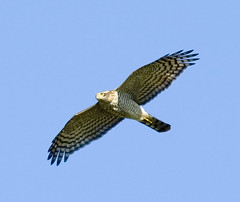Bird of Interest – Sparrowhawk
As an homage to all the interesting bird species which I find on my bird surveys through Reading, I have decided to make a sort of fact sheet of the most interesting species which can be spotted right here in Reading.
As mentioned last earlier, whilst undertaking my bird survey on campus, I spotted a nesting Sparrowhawk and Juvenile in the middle of campus woodland. It was a wonderful site, with the gentle kew kew kew alarm call resonating through the woodland.

The Sparrowhawk (Accipiter nisus) is a widespread and common raptor bird that catches small birds – not just sparrows – in low-level flight. In terms of abundance, it ranks second only to the Kestrel, although the Sparrowhawk is harder to observe than that species of raptor.
In terms of identification, all birds have relatively short, rounded wings, a proportionally long, barred tail, long legs and yellow eyes. The males are considerably smaller than the female, and also differs in plumage. The adult male has blue-grey upper parts and pale underparts that are strongly barred and reddish-brown in colour. The adult female in comparison has grey-brown upper parts and pale underparts with finer, dark barring.
This is a bird typically associated with woodland habitats, and constructs a twig nest in a tree – conifers are usually favours – and nesting areas tend to form the focal point for a nesting pairs territory. Hunting birds are most active at dawn and dusk, but the main way of observation is the characteristic kew kew kew call when alarmed.
Reference List:
- Sterry.P., (2004) Collins Complete Guide to British Birds. Harper Collins Publishing Ltd, London.
About Thomas Whitlock
I'm a third student at the University of Reading, currently studied for a degree in Zoology. I have a wide interest in biodiversity, most notably British wildlife. I have an especial interest in British mammals and birds. I hope to become a wildlife cameraman or photographer after I graduate, and I feel that blogging will be a key component of any future job in Zoology. This is my first blog, so please be kind!

